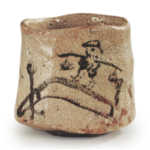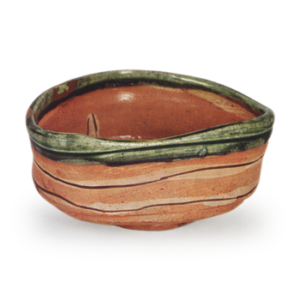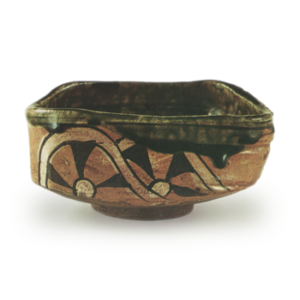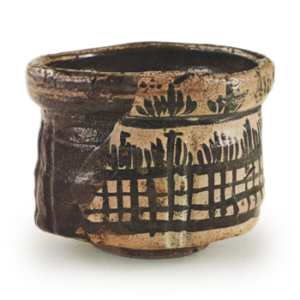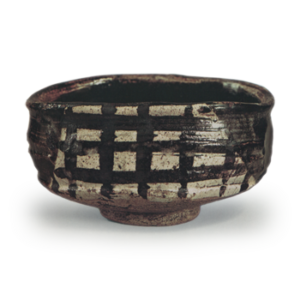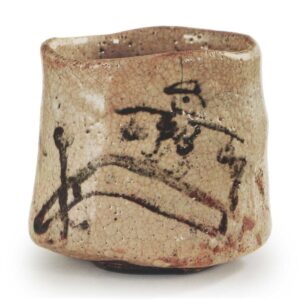
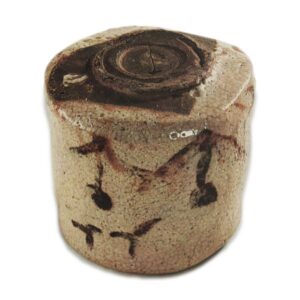
Height: 10.0 – 10.4 cm
Diameter: 10.1 cm
Foot diameter: 6.3 cm
Height of rim: 0.5 cm
There are surprisingly few cylindrical Shino tea bowls. The most famous examples are the Hashihime tea bowl in the Tokyo National Museum collection and the bamboo shoot tea bowl, which was recently acquired by the Tokugawa Art Museum in Nagoya. The only other examples are the Shino Oribe cylindrical tea bowls, which are mentioned in the Taisho Meiki Kan and which came from the Yabuuchi family.
The bamboo shoot tea bowl, for example, was clearly made as a side dish. In that sense, this tea bowl with a bridge and people design, which is thought to have been made as a tea bowl from the start, is both rare and valuable.
It is about the same size as the Hashihime (11.6 cm high, 12.7-11.3 cm in diameter, 7.5 cm in diameter at the foot), and, like other Shino tea bowls, it was made using a method in which the shape is quickly adjusted by hand after being pulled on the potter’s wheel. The sharp scraping around the waist and the bevelling on the body show a very free and uninhibited style of shaping.
The glaze color is somewhat cold, perhaps because the overall piece is fired hard. This could be considered a weakness, but the piece is endearing, evoking a carefree, peaceful rural landscape with its figures, such as the scarecrow carrying a yoke across a bridge, the flowers blooming in the fields, and the birds flying in the sky.
The coloring of the iron painting is strong and fiery, especially around the flowers and plants, but one of the three birds is hidden under the glaze, and the two pine trees are also faintly blurred, probably because of the thick glaze layer.
The clay is a dense clay with little yellowish tinge and a slight grayish tinge. The foot ring is roughly cut out and then a stick is inserted into the wide edge to make a double foot ring, giving it a very strong appearance.
The kiln mark is a single character within the foot ring. It is said that the single character mark is the mark of Motokura, one of the Seto Jussaku potters selected by Furuta Oribe, but , even though it is the same Ichimonji, it is slightly different from the Ichimonji of Oribe tea bowls such as “Masagaki” and “Shofu”. It is more like a sharp cut than a carving with a stick, and in this respect it is similar to the “Hashihime” Ichimonji kiln mark.
The inside is almost a perfect circle with a shallow spiral-shaped tea pool, and the glaze is thick, with large and small cracks appearing all over the surface. The inside of the neck is slightly narrowed from the inside of the mouth to the rim, forming a mountain path shape, and there are three vertical grooves around the rim. It is probably not from the Okaya Middle Kiln.
This famous bowl was the center of attention at the Kōnoike Shōreitai exhibition in 1940, but its whereabouts were unknown for some time after that.
The box is inscribed with the name “Shitakusai”, and on the lid is the inscription “Shino tea bowl picture on lid”, and on the underside of the lid is the inscription “Nininbashi kōjō kasanagashi ryūsui furanai Shitakusai (signature)”.

